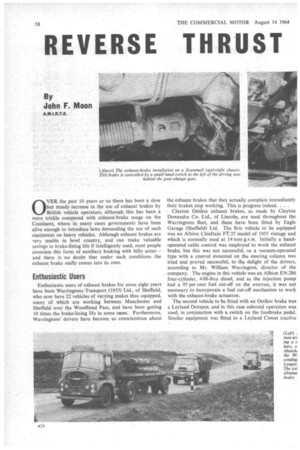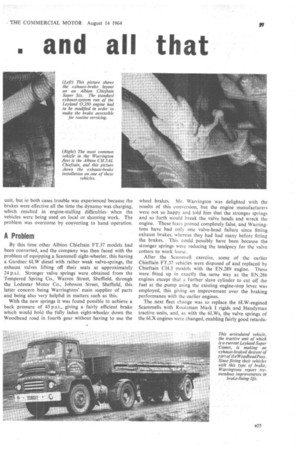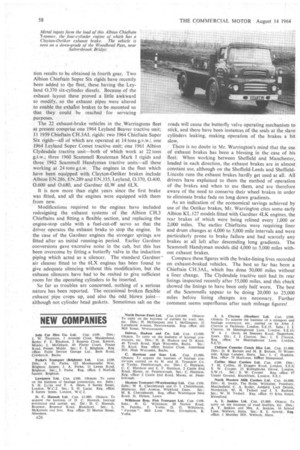REVERSE THRUST • and all that
Page 58

Page 59

Page 60

If you've noticed an error in this article please click here to report it so we can fix it.
OVER the past 10 years or so there has been a slow but steady increase in the use of exhaust brakes by British vehicle operators, although this has been a mere trickle compared with exhaust-brake usage on the Continent, where in many cases governments have been alive enough to introduce laws demanding the use of such equipment on heavy vehicles. Although exhaust brakes are very usable in level country, and can make valuable savings in brake-lining life if intelligently used, most people associate this form of auxiliary braking with hilly areas— and there is no doubt that under such conditions the exhaust brake really comes into its own.
Enthusiastic Users
Enthusiastic users of exhaust brakes for some eight years have been Warringtons'Transport (1955) Ltd., of Sheffield, who now have 22 vehicles of varying makes thus equipped, many of which are working between Manchester and Sheffield over the Woodhead Pass, and have been getting 10 times the brake-lining life in some cases. Furthermore, Warringtons' drivers have become so conscientious about the exhaust brakes that they actually complain immediately their brakes stop working. This is progress indeed. . . .
Clayton Oetiker exhaust brakes, as made by Clayton Dewandre Co. Ltd., of Lincoln, are used throughout the Warringtons fleet, and these have been fitted by Eagle Garage (Sheffield) Ltd. The first vehicle to be equipped was an Albion Chieftain FT.37 model of 1955 vintage and which is normally used at 14 tons g.v.w. Initially a handoperated cable control was employed to work the exhaust brake, but this was not successful, so a vacuum-operated type with a control mounted on the steering column was tried and proved successful, to the delight of the drivers, according to Mr. William Warrington, director of the company. The engine in this vehicle was an Albion EN.286 four-cylinder, 4.88-litre diesel, and as the injection pump had a 95 per cent fuel cut-off on the overrun, it was not necessary to incorporate a fuel cut-off mechanism to work with the exhaust-brake actuation.
The second vehicle to be fitted with an Oetiker brake was a Leyland Octopus, and in this case solenoid operation was used, in conjunction with a switch on the footbrake pedal. Similar equipment was fitted to a Leyland Comet tractive unit, but in both cases trouble was experienced because the brakes were effective all the time the dynamo was charging, which resulted in engine-stalling difficulties when the vehicles were being used on local or shunting work. The problem was overcome by converting to hand operation.
A Problem
By this time other Albion Chieftain FT.37 models had been converted, and the company was then faced with the problem of equipping a Scammell eight-wheeler, this having a Gardner 6LW diesel with rather weak valve-springs, the exhaust valves lifting off their seats at approximately 24 psi. Stronger valve springs were obtained from the Tempered Spring Co., Warren Street, Sheffield, through the Lodestar Motor Co., Johnson Street, Sheffield, this latter concern being Warringtons' main supplier of parts and being also very helpful in matters such as this.
With the new springs it was found possible to achieve a back pressure of 45 p.s.i., giving a fairly efficient brake which would hold the fully laden eight-wheeler down the Woodhead road in fourth gear without having to use the wheel brakes. Mr. Warrington was delighted with the results of this conversion, but the engine manufacturers were not so happy and told him that the stronger springs and so forth would break the valve heads and wreck the engine. These fears proved completely false, and Warringtons have had only one valve-head failure since fitting exhaust brakes, whereas they had had many before fitting the brakes. This could possibly have been because the stronger springs were reducing the tendpney for the valve cotters to work loose.
After the Scammell exercise, some of the earlier Chieftain FT.37 vehicles were disposed of and replaced by Chieftain CH.3 models with the EN.289 engine. These were fitted up in exactly the, same way as the EN.286 engines except that a further slave cylinder to cut off the fuel at the pump using the existing engine-stop lever, was employed, this giving an improvement over the braking performance with the earlier engines.
The next fleet change was to replace the 6LW-engined Scammells with Routeman Mark 1 rigids and Handyman tractive units, and, as with the 6LWs, the valve springs of the 6LX engines were changed, enabling fairly good retarda lion results to be obtained in fourth gear, Two Albion Chieftain Super Six rigids have recently been added to ttie fleet, these having the Leyland 0.370 six-cylinder diesels. Because of the exhaust layout these proved a little awkward to modify, so the exhaust pipes were altered to enable the exhatist brakes to be mounted so that they could be reached for servicing purposes.
The 22 exhaust-brake vehicles in the ,Warringtons fleet at present comprise one 1964 Leyland Beaver tractive unit; 11 1959 Chieftain CH.3AL rigids: two 1964 Chieftain Super Six rigids—all of which are operated at 14 tons g.v.w.; one 1964 Leyland Super Comet tractive unit; one 1961 Albion Clydesdale tractive unit—both of which work at 22 tons g.t.w.; three 1960 Scammell Routeman Mark I rigids and three 1962 Scam mell Handyman tractive units—all these working at 24 tons g.t.W. The engines in the fleet which have been equipped with. Clayton-Oetiker brakes include Albion EN.286, EN.289 and EN .335. Leyland, 0.370, 0.400, 0.600 and 0.680, and Gardner 6LW and 6LX.
It is now more than eight years since the first brake was fitted, and all the engines were equipped with them from new.
Modifications required to the engines have included redesigning the exhaust systems of the Albion CH.3 Chieftains and fitting a flexible section, and replacing the engine-stop cable with a fuel-cut-off servo so that the driver operates the exhaust brake to stop the engine. In the case of the Gardner engines the stronger springs are fitted after an initial running-in period. Earlier Gardner conversions gave excessive noise in the cab, but this has been overcome by fitting a butterfly valve in the induction piping which acted as a silencer. The standard Gardner air cleaner fitted to the 6LX engines has been found to give adequate silencing without this modification, but the exhaust silencers have had 'to be resited to give sufficient room for the operating cylinders to be inserted.
So far as troubles are concerned, nothing of a serious nature has been reported. The occasional broken flexible exhaust pipe crops up, and also the odd blown joint— although not cylinder head gaskets. Sometimes salt on the roads will cause the butterfly valve operating mechanism to stick, and there have been instances of the seals at the slave cylinders leaking, making operation of the brakes a bit slow.
There is no doubt in Mr. Warrington's mind that the use of exhaust brakes has been a blessing in the case of his fleet. When working between Sheffield and Manchester, loaded in each direction, the exhaust brakes are in almost constant use, although on the Sheffield-Leeds and SheffieldLincoln runs the exhaust brakes hardly get used at all. All drivers have explained to them the method of operation of the brakes and when to use them, and are therefore aware of the need to conserve their wheel brakes in order to eliminate brake fade on long down gradients.
As an indication of the economical savings achieved by use of the Oetiker brakes, Mr. Warrington cites some early Albion KL.127 models fitted with Gardner 4LK engines, the rear brakes of which were being relined every 1,000 or 2,000 miles, The earlier Chieftains were requiring liner and drum changes at 4,000 to 5,000 mile intervals and were particularly prone to brake failure and had scarcely any brakes at all left after descending long gradients. The Scam mell Handyman models did 4,000 to 5,000 miles without exhaust brakes.
Compare these figures with the brake-lining lives recorded on exhaust-braked vehicles. The best so far has been a Chieftain CH.3AL, which has done 50,000 miles without a liner change. The Clydesdale tractive unit had its rear linings inspected recently after 55,000 miles, and this check showed the linings to have been only half worn. The best of the Scammells appear to be doing 20,000 to 25,000 miles before lining changes are necessary. Further comment seems superfluous after such mileage figures!




















































































































